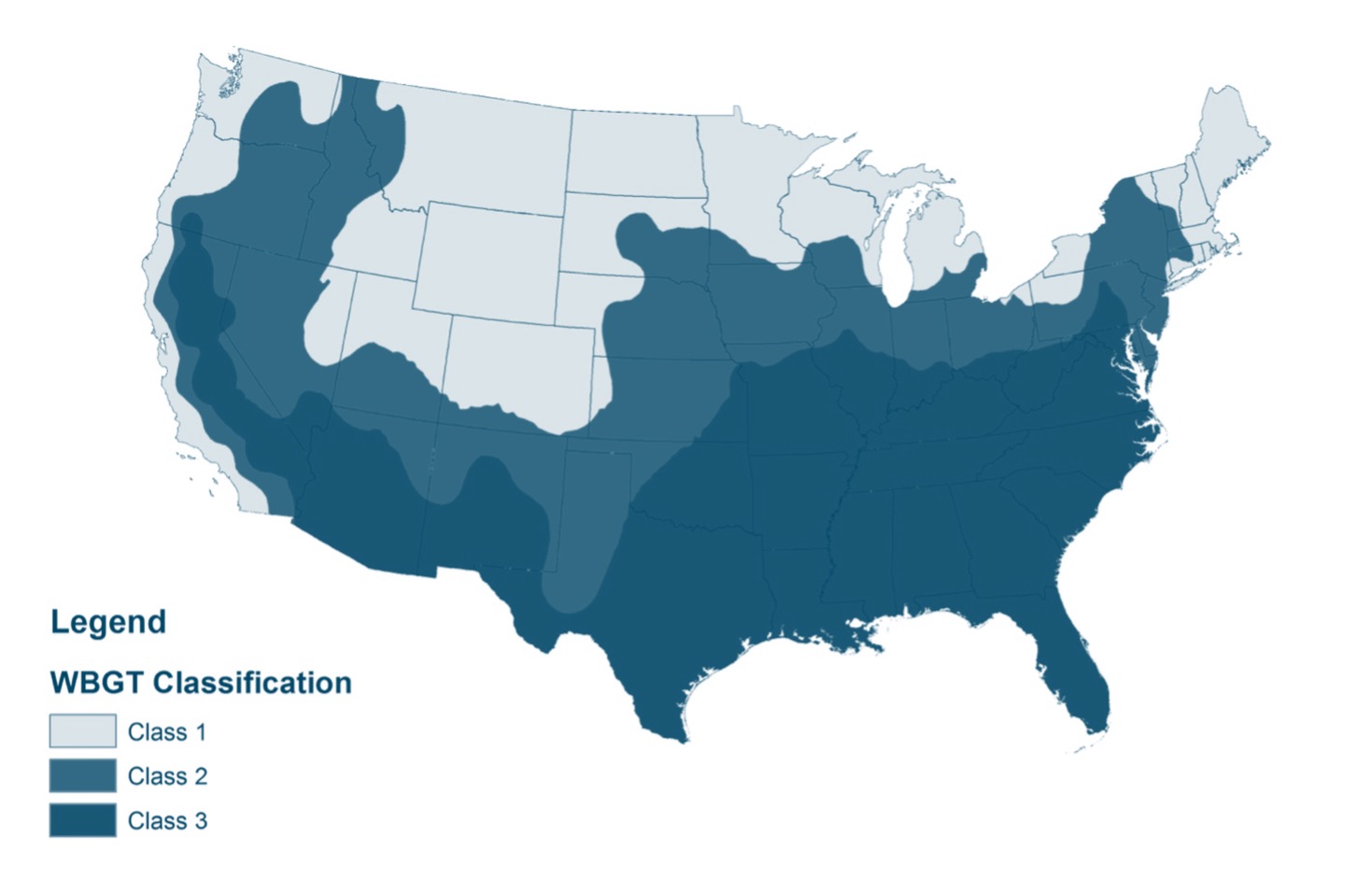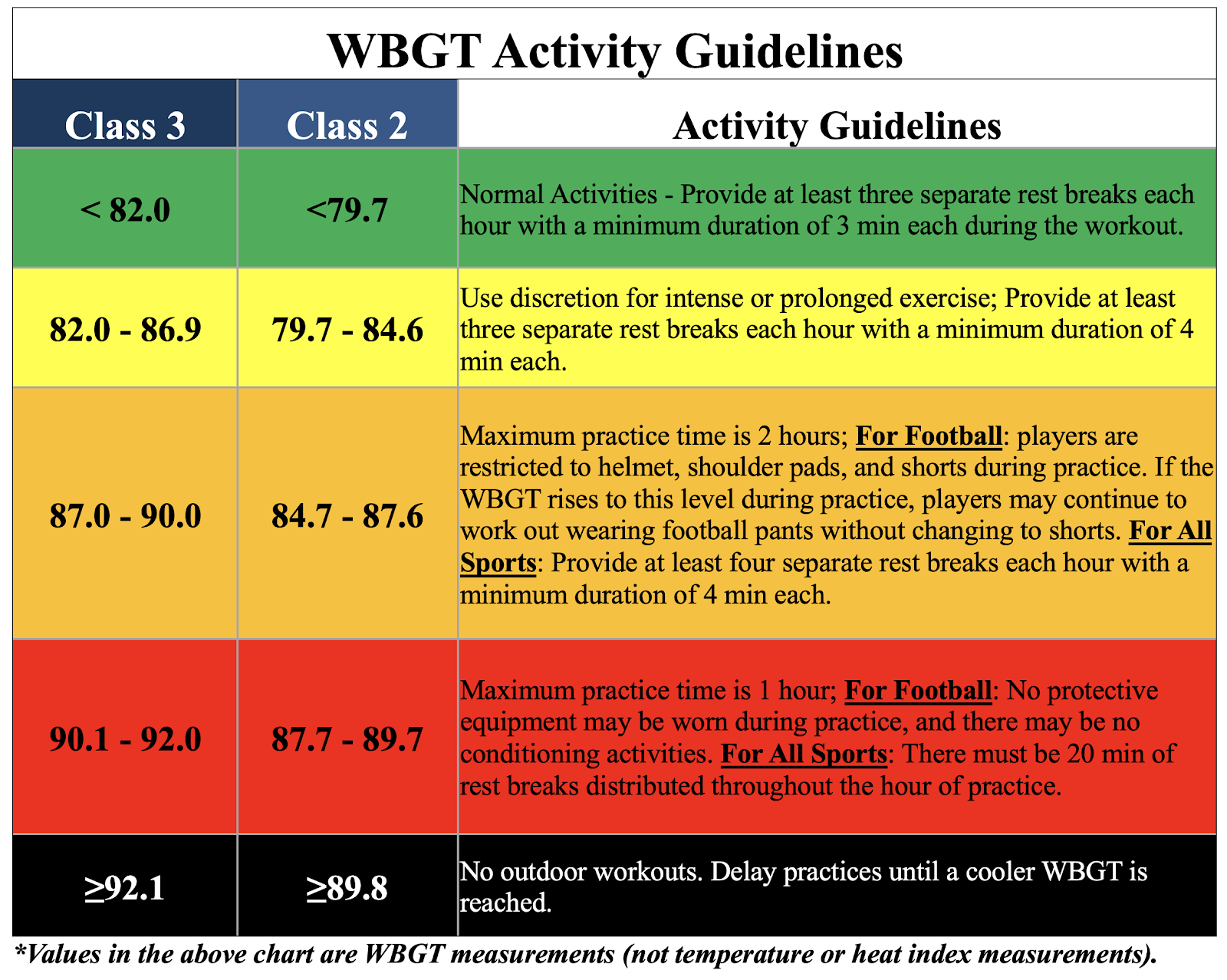Graham ISD Environmental Monitoring Policy
Graham ISD Athletics Environmental Policy
Exposure to excessive heat and cold can not only be uncomfortable for the participants but also coaching/support staff, friends, and family that are in attendance at practices, contests or events. In addition to making these individuals uncomfortable, excessive heat or cold has been proven to impair athletic performance and can lead to life-threatening medical emergencies. Hypothermia is a significant drop in body temperature and it can occur at temperatures above freezing. A wet and windy temperature in the mid-30s can feel much worse than a dry and calm evening with the temperature at 32 degrees Fahrenheit. Hyperthermia may result in increased core temperatures which can become a medical emergency that could result in death if not treated quickly and appropriately.
When developing this policy Graham ISD personnel evaluated multiple policies from districts across the state. GISD then attempted to construct a policy that will be in the best interests of the student-athletes, support staff, and fans of Steer and Lady Blues athletes. For the cold policy it is important to understand that what may be considered too cold to participate in one part of the state may be acceptable in another part of the state or in another state altogether. The heat policy has been established by the governing body of athletics in the state of Texas (University Interscholastic League).
2024-2025 Recommended Heat Protocols and Procedures for Outside UIL Athletic and Marching Band Activities
In 2023, the UIL approved Wet Bulb Globe Temperature (WBGT) as the recommended forecast measurement to be used to monitor environmental conditions during outdoor physical activities. WBGT estimates the effect of temperature, relative humidity, wind speed, and solar radiation using a combination of temperatures from three thermometers.
The American College of Sports Medicine has recommended WBGT guidelines that dictate modifications in activity (work: rest ratios, hydration breaks, equipment worn, length of practice) at given WBGT temperatures to prevent Exertional Heat Stroke. The below table represents modified guidelines from the American College of Sports Medicine regarding:
-
The scheduling of practices at appropriate WBGT levels
-
The ratio of workout time to time allotted for rest and hydration at various WBGT levels
-
The WBGT levels at which activities should be terminated
It is recommended that UIL member schools utilize WBGT to monitor practice and workout conditions and alter practices as outlined in the chart below based on recommendations from the American College of Sports Medicine.


WBGT Forecasting Resource
https://convergence.unc.edu/tools/wbgt/
-
For Graham Select Texas UIL Class 3,”
-
Click the “Submit” button at the bottom and scroll down the page to see the forecast.
-
Scroll further down the page to see the WBGT activity guidelines.
Graham ISD also utilizes the Perry Weather Station. There are three in the district. They are located on the CTE building at GHS, the GJH building next to the practice field and the right field light pole at the Steer baseball field. These stations will be used for WBGT readings. Athletic Trainers may forego those readings and utilize a Kestrel 5400 hand held device to get the most accurate reading for a specific field/location.
WBGT Means and Methods of Measurement when practices are outside in WBGT of 80.0 or higher
-
It is recommended that schools utilize a scientifically approved instrument that measures Wet Bulb Globe Temperature (WBGT) or other scientifically proven method, such as an internet-based weather station software or application, to monitor the wet bulb globe temperature.
-
If utilizing an on-site instrument, the instrument should be set up 30 minutes prior to practice and should be read 15 minutes prior to the start of practice. If utilizing an internet-based application, the WBGT should also be checked at the 15-minute mark prior to practice. In both cases, WBGT readings should be taken every 30 minutes during practice.
-
When there’s a change in WBGT from one level to the next, responsible modifications to practice activities should be made based on the above WBGT Activity Guidelines.
-
It is recommended that schools record and keep on file the WBGT temperatures associated for outside practices.
-
Practices are defined as the time period that a participant engages in a coach/director-supervised, school-approved sport or band conditioning-related activity. Practices are timed from when players report to the outside practice/workout area until the players leave the area.
Emergency Action Plans & Procedures for the Prevention of Heat Related Illness
-
Each member school’s emergency action plan must include procedures to address heat emergencies that include onsite rapid cooling using cold-water immersion or equivalent means.
-
Rapid cooling zones will be available for each outdoor athletic and marching band contest, practice, workout, or conditioning session that is held in wet bulb globe temperatures of 80 degrees or higher. Rapid cooling zones will have immediate availability of cold-water immersion tubs that will be filled with ice and water and wrapped around individuals to rapidly cool internal body temperature.
-
Coaches and directors will have a policy of unrestricted access to water at all times and a student- athlete will never be denied access to water.
-
Rest breaks will involve unlimited hydration intake and rest without any activity involved.
Competitions & Possible Modifications to Competitions
For more information on heat stress and heat related illness, including additional resources, click HERE.
Graham ISD Cold Policy
After evaluating multiple cold weather policies it was determined that the most accurate way to evaluate environmental conditions is to use the AccuWeather RealFeel factor. This factor takes into account multiple parameters. They are ambient temperature, wind speed, solar intensity, humidity/precipitation intensity/type, elevation, and atmospheric pressure. This is a better indicator for environmental conditions. This factor can be obtained either on the Accuweather app downloaded onto the user’s smartphone or by going to www.accuweather.com and using the Graham zip code of 76450.
While adherence to the recommendations and the policy listed below is vital to the individual who will be participating in the elements it is also critical that proper clothing is worn by the athlete to help maintain body heat as best as possible. The lower the RealFeel factor is the more important it is for the athlete to dress in layers and also stay dry. Also, heat loss from the head and neck area can account for up to 50% of total heat loss so that area should be covered as well. Other extremities should also be covered as well. This includes arms, legs, and hands.
Cold Exposure:
-
Breathing of cold air can increase the chances of asthma attacks because of bronchospasm
-
Coughing, chest tightness, and burning sensations in nasal passages and throat
-
Reduction in strength, power, endurance and aerobic activity
-
Reduction in core body temperature will cause a reduction in motor output
Cold Recognition:
-
Shivering is a means to generate body heat
-
Excessive shivering contributes to fatigue and loss of motor skills
-
Numbness and pain in fingers, toes, ears, and exposed tissue
-
Reduction in core temperature can cause an athlete to exhibit sluggishness, slowed speech, and disorientation
Temperature Determination:
-
Coaches or Athletic Trainer will obtain weather report specifically looking at the RealFeel temperature from Accuweather app or www.accuweather.com and use Graham, Texas or 76450 zip code.
-
The report should be taken 30 minutes prior to the beginning of outdoor activities on practice days. On game days it should be taken at a time (suggested 2 pm) that would allow the visiting team to alter travel plans.
-
The RealFeel temperature should be used to make modifications/cancellations
Cold Policy Games:
-
This policy is for games played at Graham ISD facilities only. When GISD teams are the visiting team then that school district’s policy will be followed.
-
The game should be rescheduled/canceled if the RealFeel is 25 or below by 2 pm on game day or if it is forecasted to be at that level by the beginning of the contest.
-
If the RealFeel is between 25-30 there should be consideration given to shortening the game/contest. This could also include no extra time periods being played.
Recommended Actions for Practices:
RealFeel 32-35 with precipitation
RealFeel below 32 with precipitation
RealFeel 32-35 (Dry)
RealFeel 26-31 (Dry)
RealFeel of 25 or below
Graham ISD Lightning Policy
Lightning is the most consistent and significant weather hazard that may affect interscholastic athletes and other outdoor activities. Within the United States, the National Severe Storms Laboratory (NSSL) estimates more than 100 fatalities and 400-500 injuries requiring medical treatment occur from lightning strikes every year. While the probability of being struck by lightning is extremely low, the odds are significantly greater when a storm is in the area and the proper safety precautions are not followed. Three-Quarters of all lightning casualties occur between May and September, and nearly four out of five occur between 10 am and 7 pm.
Chain of Command:
Athletic Trainer -> Head Coach/Game Officials->Game Administrators->Assistant Coaches
Designated Weather Watchers:
Graham ISD uses the Perry Weather lightning warning system to determine if lightning is within an unsafe distance (10 miles) of GISD athletic facilities. Athletic Trainers will monitor current weather and keep members of the chain of command informed. All representatives in the “Chain of Command” should monitor local weather forecast and maintain awareness of incoming thunderstorms.
Perry Weather Lightning Warning System
-
Suspension of Activities-Participants and staff should take cover in a safe shelter until the warning has expired. Safe shelter is defined as any building where doors and windows can be closed. A baseball or softball dugout or underneath bleachers should NOT be considered safe shelter. In the absence of a building, a car or school bus with the windows up is the next best option. It is recommended that spectators seek shelter as well.
-
Lightning Warning Systems Locations
-
-
-
-
-
Lightning Warning System Activation
-
1. Audible horns attached to the warning systems sound when lightning is within a 10-mile radius of the location. This distance allows for the suspension of practices, games, recess, PE, roof or grounds work by maintenance, or other outdoor activity and indicate movement to indoor safe areas is required. If you are close enough to either of the two stationary warning systems, you may hear the horns, if outside.
-
A single horn blasts will sound announcing an active lightning event.
-
While lightning is present and activities are delayed, a yellow strobe light on the warning device will flash
-
A 3 horn blast tone will sound the all clear.
-
2. Electronic alerts, SMS text messaging and emails, will be generated and sent to Emergency Management, Sports Medicine & appropriate athletic personnel, band directors, principals, assistant principals. These will signify when the alert has sounded and also when the all-clear has been given.
-
3. The all-clear will sound once there has not been a lightning strike within 10 miles of the facility for 30 consecutive minutes. Outdoor activity should NOT resume until the all-clear has sounded. This includes warming up, stretching, field set up or any any other outdoor activity.

 Additional settings for Safari Browser.
Additional settings for Safari Browser.

